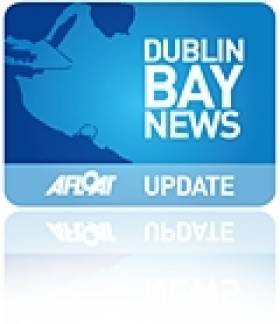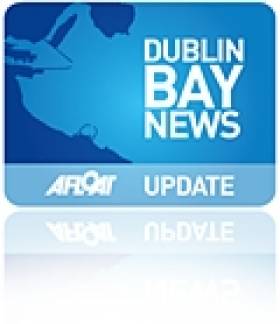Displaying items by tag: Dun Laoghaire
'No Commercial Benefits' In Dun Laoghaire Cruise Berth Plan
#DunLaoghaire - Plans by the Dun Laoghaire Harbour Company to build a 400m berth for cruise liners have raised the ire of local dinghy sailors - whose petition to save their sport has attracted nearly 1,500 signatures.
Now local resident Roger Bannon has joined the chorus of disapproval, expressing his confusion at the reasoning behind the harbour company's plans in his submission as part of the ongoing public consultation.
Read what he had to say in his letter below:
I am utterly confused by the rationale purported to underlie this proposal.
Dublin Port has already made the decision to significantly enhance its facilities for accommodating cruise liners.
Consequently, I fail to understand the business case for replicating such a facility so adjacently in Dun Laoghaire, a location with much inferior infrastructure which will require major dredging and construction.
Furthermore, it does seem strange that such a berthing facility could be regarded as a safe all-weather mooring for large vessels when the harbour is so exposed to north-easterly gales which can produce a significant 'scend' in parts of the harbour which are not protected by a breakwater.
The business community in Dun Laoghaire cannot identify any local commercial benefits arising from this proposal.
- Most visitors from cruise liners spend very little time ashore and in the case of Dun Laoghaire; the vast majority will get on the DART or a coach tour bus and head into Dublin for a few hours.
- There are no attractions in Dun Laoghaire which could justify trying to persuade liner passengers spending time in the area.
- The installation of the planned infrastructure to accommodate cruise liners would destroy much of the attractiveness of the harbour for both visitors and residents.
If this totally unsuitable development is allowed to proceed, the so-called economic benefits will be greatly outweighed by the loss of existing established economic activities generated by visitors to the piers and leisure boating users of the harbour.
Dun Laoghaire Harbour is an iconic, long-established community resource enjoyed by Dubliners for hundreds of years. It is not a commercial opportunity waiting to be developed by a QUANGO with no accountability to the local community.
It is a wonderful unique facility which would be envied by most other major cities but there seems to be a determination to desecrate it in the interest of generating an economic return.
Can the Harbour Board point to a precedent elsewhere in the world where the creation of major cruise liner berthing facility has worked to the benefit of a location and its community when immediately adjacent to a major city?
The truly successful facilities, such as Vancouver, Southampton, Sydney, etc have one major obvious attribute in common which is that the berths are all located virtually in the heart of the city, usually within a short walk or taxi ride of the city centre.
The days of Dun Laoghaire harbour being used as a commercial port are now over. There is no need for a Harbour Board and this master plan looks like an exercise in self-perpetuation of an unjustified bureaucracy.
- The maritime responsibilities for the harbour should be devolved to Dublin Port.
- The overall responsibility for the harbour should be allocated to the Dun Laoghaire-Rathdown County Council.
- All future development of the harbour and its environs should be for the benefit of the local community and the larger Dublin Metropolitan Area which regularly enjoys its traditional and relaxing charms.
- It is a national resource which should be treated, valued and preserved in a manner similar to the Phoenix Park.
- The entire plan is comprised of vague wishful thinking with no financial or economic validation.
- The local community, residents and businesses do not want it.
- The logic of going into direct competition with Dublin Port has not been justified.
- There are no drawings which illustrate the visual impact of the proposed development on the environment.
There is no meaningful evaluation of the impact of these proposals on the existing users of the harbour.
Online Petition To 'Save Dun Laoghaire Dinghy Sailing'
#DunLaoghaire - An online petition to 'save Dun Laoghaire dinghy sailing' has attracted nearly 1,400 signatures.
Set up by local Fireball sailor Peter Doherty, the petition rails against recently unveiled plans by the Dun Laoghaire Harbour Company to build a 400m berth for cruise liners.
It's feared that the increase in cruise traffic will "destroy dinghy sailing in the harbour", described as "Ireland's most celebrated dinghy sailing location".
Using the harbour all year round, and availing of the local amenities, the dinghy sailing community feels short shifted by the harbour company's plans.
That's especially when "at most, [cruise] passengers will spend a day in Dun Laoghaire town, assuming they don't bypass the area entirely on their way into the city centre."
#vdlr –With an entry list the envy of regatta organisers everywhere, July's Volvo Dun Laoghaire Regatta (VDLR) has received a massive entry of 302 boats so far with three months to run to its first gun. Over 63 different yacht clubs are represented in a fleet that will split into 20 different sailing classes for the four day extravaganza at the Irish east coast port. Enthusiastic insiders say the tenth anniversary of the event may yet hit its all time high of 500 boats by July 9 but a more modest reckoning of 400 plus will certainly match the 2013 and 2011 editions of Ireland's largest sailing event.
Run by the four waterfront clubs of the DMYC, RIYC, NYC and RSt.GYC's this year's event is under the stewardship of former Fastnet race winner Tim Goodbody and Dragon Edinburgh Cup winner Martin Byrne. An overview of the biennial event was published by Afloat.ie last weekend in WM Nixon's blog here.
The bulk of entries come from the Dublin Bay area itself but there is also strong interest from along the east coast from Greystones, Arklow, Howth and Skerries. Most encouragingly, the event is proving to be a draw for boats from further afield too with entries from across the Irish Sea some of the first to sign up.
As previoulsy reported by Afloat.ie, the following events are confirmed as part of the event:
Royal Dee Yacht Club Irish Sea Offshore Championship
J109 Irish National Championship
RS Elite Irish National Championship
Beneteau First 21 Irish Championship
Wayfarer Irish National Championship
GP 14 Leinster Championship
J24 Leinster Championship
In encouraging news for dinghy sailing (that has separately been given a shot in the arm this year by local DBSC organisers), it looks like VDLR will also see a lift for centreboard classes. 2015 will see a record number of dinghies classes participating. In addition to the regular one designs such as the Mermaid, Flying 15, Squib, Fireball, IDRA 14 – organisers are welcoming the GP14, Wayfarer, RS200/RS400, Laser classes to the regatta with their own starts.
It is the first visit to the Regatta for the GP14 fleet and organisers are very much looking forward to welcoming the class, all of whom will be from visiting clubs from around the country. An expected entry of 40 GP14's are expected and they will be hosting their Leinster Championships as part of the Regatta.
The Wayfarers are returning after running their a successful UK Nationals within the 2011 Regatta and this year they will be running their Irish Nationals, an expected entry of 20 visiting Wayfarers are expected.
Big entries are also expected from both the Laser and RS fleets. It still remians to be seen if the PY class can muster sufficient numbers.
VDLR had issues recently with its online payment. To accommodate anyone who has had difficulties it has extended the early bird discounted entry fee offer deadline to Friday, April 17th.
Dun Laoghaire Harbour Masterplan Shortlisted for Prestigious Award for Planning Excellence
#dlmasterplan – Dun Laoghaire Harbour Masterplan has been shortlisted in the 'Excellence in Planning to Create Economically Successful Places' category at the 2015 Planning Awards for Excellence. The Awards, run by the Royal Town Planning Institute (RTPI) will be held at the Pullman London St Pancras Monday, 6th July 2015.
The Dun Laoghaire Harbour Masterplan was published in 2011 following extensive consultation with harbour stakeholders. The plan seeks to extend the recreational and amenity value of the harbour; to promote investment; and to generate sufficient revenue from commercial operations to ensure the sustainability of the maintenance programme and marine facility that the harbour provides. In short, the objective is to transform the harbour into a living, vibrant area, offering facilities for people to live, work and relax. The Masterplan envisages development over a 15 - 20 year period. It will be reviewed every five years.
Gerry Dunne, the CEO of Dun Laoghaire Harbour Company said today: "I am delighted that our Masterplan has been nominated for such a prestigious award. A huge amount of work was put into the drafting of the Masterplan which aims to transform the harbour into a living, vibrant area for people to live work and relax, while at the same time preserving the unique character that has made the harbour such an amenity over decades.
"The nomination comes at a time when we are in the midst of a public consultation process on one of the key proposals in the Masterplan – the development of a new cruise ship berth facility, to enable the harbour to cater for new, larger cruise ships. This will be a great boost for all those who want to see Dun Laoghaire Harbour thrive", Mr. Dunne said
The RTPI represents 23,000 planning professionals worldwide and promotes spatial planning, shapes policy and raises professional standards. The Awards for Planning Excellence have been run by the RTPI for over 30 years to recognise planning excellence.
This year's headline sponsor is AECOM with other sponsors and supporters including Bilfinger GVA, The Planner, Planning Aid England and the Royal Borough of Kensington and Chelsea.
Janet Askew, President of the Royal Town Planning Institute said: "The shortlist reflects the very best planning projects, strategies and processes that are helping to make great places for people to live and work. The 80 finalists highlight exceptional examples of planning that have made an impact and brought considerable benefits. It will be a tremendous challenge picking individual category winners from such a high quality field."
Andrew Jones, Practice Leader for Design, Planning + Economics, EMEA at AECOM said:
"AECOM is proud to be this year's headline sponsor of the RTPI's Awards for Planning Excellence. The shortlist is a diverse mixture of outstanding examples of planning, which really demonstrate the impact the profession has on quality and delivery in the built environment. We look forward to seeing which entries the judges select as the category winners."
Projects on the shortlist have been recognised for their national contribution to planning and demonstrate how significant schemes can be delivered speedily through the planning and other consents systems.
#sdls – A new group, Save Dun Laoghaire Sailing (SDLS), has come forward with radical proposals for a re-configuration of the harbour in order to accommodate the proposed Cruise Liner Berth in the harbour, (plans of which were revealed on Afloat.ie last Thursday), while at the same time maintaining the town's pre-eminent role as Ireland's greatest sailing centre.
A spokesperson for SDLS said that the new group's proposals were still only at a very preliminary stage, but the extremely short time lapse permitted for objections or modifications to the Harbour Company's plan has meant that they have had to act in great haste.
However, the spokesperson asserted that the harbour's thousands of recreational sailors are so concerned at some elements of the new plan - such as the rumoured intention to forbid boats manoeuvring under sail only, let alone racing, within the harbour – that they have had no trouble in recruiting supporters, and an ad hoc inaugural meeting in recent days instructed an acting committee to proceed as rapidly as possible.
The underlying thinking behind SDLS's proposals is that the areas of activity for the different interests within the harbour should be clearly delineated. "Good fences make good neighbours" is the group's core philosophy, and with this in mind they have proposed two new in-harbour breakwaters in order that the large area in the centre of the harbour, which is intended for use by the new cruise liner berthing facilities, will be walled off from other areas of the port.
This will be done by a new in-harbour breakwater from St Michael's Pier to the outer end of the present East Pier, and another small in-harbour breakwater closing off the present outer entrance to the marina.
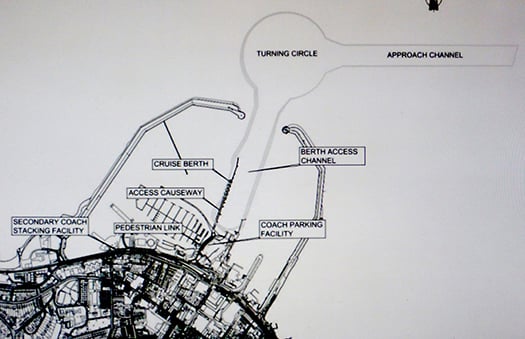
Dun Laoghaire Harbour with the Harbour Company's proposed Cruise Liner Berth occupying most of the space between St Michael's Pier and the harbour entrance

Radical proposals from SDLS (Save Dun Laoghaire Sailing) include new Eastern and Western entrances to the harbour, and two new in-harbour breakwaters which will clearly separate the cruise liner areas from the recreational sailing and boating areas. In effect, three new harbours will be created.
In order to make this feasible, the group has come up with the visionary concept of giving Dun Laoghaire Harbour two additional entrances. The new entrance to the east would be created by making a gap in the existing East Pier, and would inevitably be expensive, as this is exposed to onshore winds, and thus would require a very substantial sheltering breakwater. However, it would still be as cost-effective as possible, as this new Eastern Entrance would not need to be nearly as wide as the current main entrance, as that was created in order to be negotiated by the cumbersome sailing ships of the early 19th Century.
When Afloat.ie pointed out to the spokesperson (who wishes to remain anonymous for the time being) that a gap in the East Pier would result in the ending of the time-honoured tradition of South Dubliners walking the length of the pier on a Sunday, the response was that the demographic is such that an increasing number of South Dubliners are so aged as to be no longer capable of walking the entire length of the East Pier, and thus they would welcome the shorter walk to the lighthouse which will be provided by the new inner breakwater direct from St Michael's Pier.
A further question about the need for manoeuvring space for the cruise liners between their proposed berth and the East Pier elicited the reply that the Harbour Company have already made it clear that they will have to dredge a ten metre channel from the present main entrance to the new berth to serve the deeper drafted liners. Therefore the building of a new pier along the eastern edge of this dredged channel will not impinge on the cruise liners' area of access, and will moreover restrain small craft which might be sailing or racing in the eastern harbour from straying into the liner area.
SDLS is particularly enthused about the possibilities offered by he new western entrance. "For far too long, the West Pier has been more like the Wild West Pier than part of a civilised harbour," we were told. Now, with the new entrance, it will be brought centre stage, and those dinghy sailors from the RIYC, the DMYC, the INSS and the Coal Harbour who were formerly reluctant to venture into the open waters of Dublin Bay will find they have easy access to the relatively sheltered Bay waters between the West Pier and Seapoint.
SDLS conclude their initial policy document by pointing out that their plan would in effect provide the benefit of having three harbours where at present only one exists. And for further diversity, they suggest that the central commercial area for the cruise liners could possibly, in time, also accommodate some working fishing boats, as the colourful activity of hardy fisherfolk is much appreciated by cruise liner passengers
As to the fact that the creation of two new entrances means in effect that there will now be two completely separate leisure harbours on the south side of Dublin Bay with their entrances one and a half miles apart, SDLS argues that this is one of the most attractive features of their plan.
"Sailing enthusiasts from places blessed with natural advantages and numerous little ports of call, such as Cork Harbour, are always bemoaning the fact that when you sail out of Dun Laoghaire, there is nowhere convenient to go to within easy reach. But thanks to our plan, we can now envisage that a boat which has to go to sea via the new West Entrance could go out for a nice sail in Dublin Bay, and then go visiting in the eastern part of the harbour through the new Eastern Entrance, and vice versa.
Having considered these attractive options, we don't see the proposed new cruise liner berth as a problem. On the contrary, we see it as an opportunity to make Dun Laoghaire a much more interesting place to sail from".

Dun Laoghaire harbour largely as it is today, although the presence of the HSS ferry in port is now history and the contentious new library has been inserted in the tree-surrounded green space at right foreground. Photo courtesy ICC.
Editor's Note: Normally our April 1st special would be pulled at noon. But as virtually all plans for a totally artificial harbour at Dun Laoghaire, ever since the first ones more than two hundred years ago, have been initially treated as an April Fool joke, we think we'll let this one run. And further comments are welcome, for underlying the tomfoolery, a very serious situation is developing for the harbour's future.
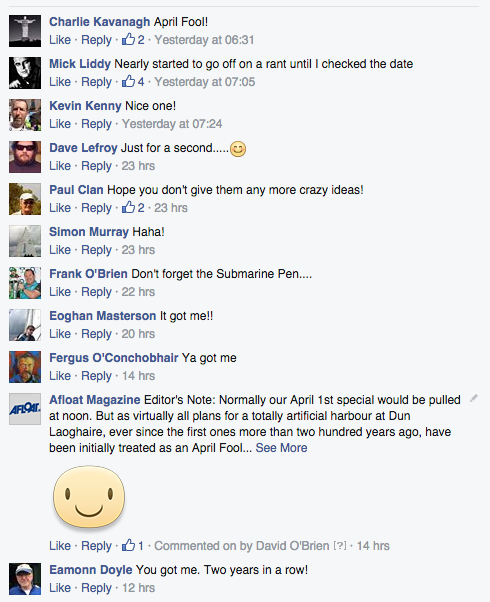
#dinghycharter – At the end of the 2014 summer sailing season as we started to look towards the winter racing series and talk of the 1720s racing in the Dublin Bay Sailing Club's Turkey Shoot and Spring Series writes Kenneth Rumball. Our dinghy sailors started to ask what was for them? A bit of head scratching and it was decided that the INSS would charter out our fleets of Lasers and double-handed dinghies to both our junior and adult sailors. Not only would these sailors benefit from having access to a boat to race in but we also supplied an INSS support boat manned by Glyn Williams to give that extra bit of security and also to act as a coach boat giving feedback to our sailors and helping them to progress their sailing. The support boat was also there to support some of our 'own boat' sailors also giving them an extra helping hand.
The 2014-2015 series has been a huge success for our sailors, a shaky start last October where a lot of our sailors who had never raced before all of a sudden were thrown in the deep end and on a race track before they knew where they were. Kenneth and Alexander Rumball who raced in the Fireball and RS400 classes respectively were initially on hand to give helpful hints and advice after races and encourage all sailors along.
It has been fantastic to watch the progress of all our sailors throughout the series which culminated today in the final prize giving of the 2014-2015 series. There were some claims to Silverware from the INSS team with Lorcan Tighe claiming the first Feva trophy in the PY class, Alexander Rumball claiming third in the RS class and Kenneth Rumball and Brian Byrne claiming the overall Fireball trophy.
Plans are already a foot for the DBSC summer racing series, with our fleet available for charter.
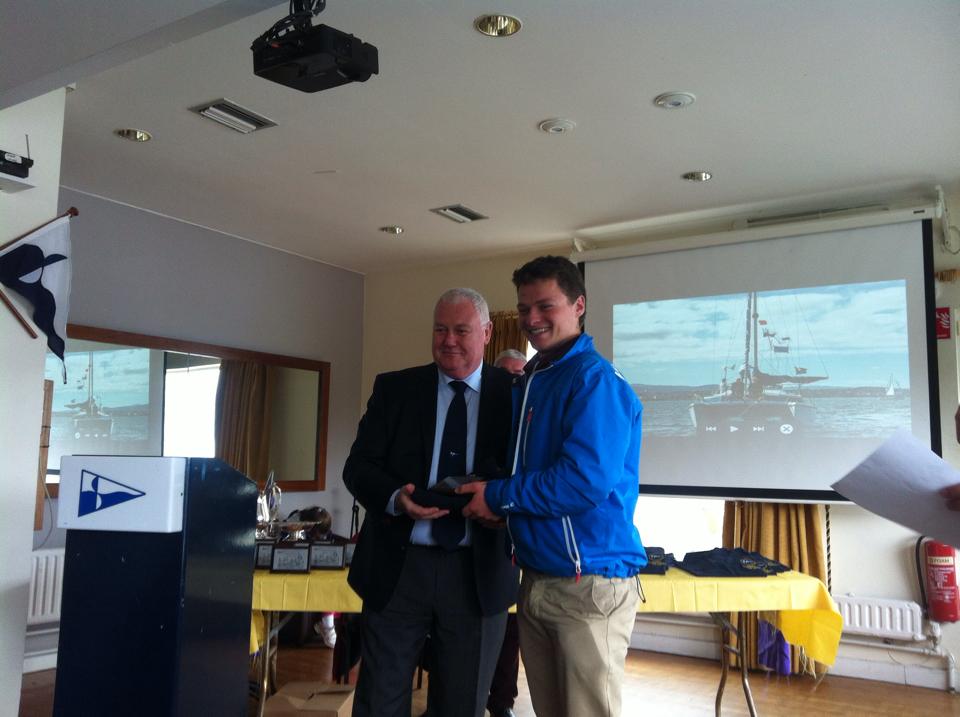
Alexander Rumball who claimed third overall in the RS Class
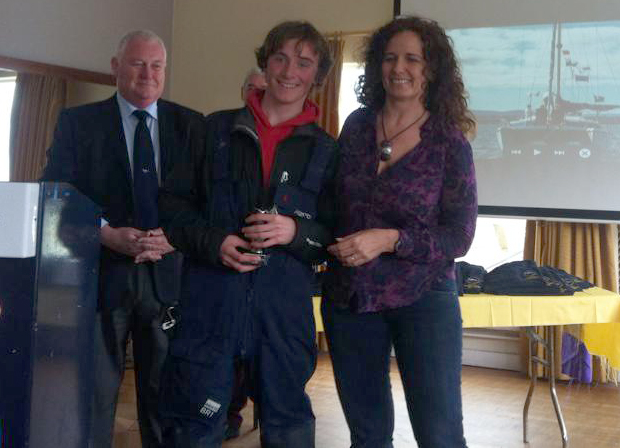
Loran Tighe of the INSS claims the Feva Trophy
#vdlr – The "suburban sailfest" which is the biennial Volvo Dun Laoghaire Regatta this year (Thursday July 9th – Sunday 12th July) is marking its tenth anniversary with the sixth edition. It's a classic Irish mix of sailing sport at all levels aboard a wide variety of boats from many and often very distant places, combining to sail with the large home fleet in Dublin Bay in thirty different classes. And on each of the four days, colourful action afloat is followed ashore by a hectic pace of post-sailing celebrations in four waterfront clubs.
Three of these are venerable institutions with their origins in the midst of the 19th Century, and their homes in historic harbourside buildings each of which is, in its own way, an architectural masterpiece. And even the "newest" of the four waterfront clubs, the Dun Laoghaire Motor Yacht Club, is this year celebrating its Golden Jubilee.
The VDLR 2015 has much to live up to, but in the spirit of this youthful event in a mature setting, the people running it bring the necessary level of enthusiasm and expertise allied to unrivalled experience to maximize the enjoyment of a unique experience. W M Nixon casts an eye over something special.
"You have to remember that it's a regatta, not a championship. Enjoyment of sport comes first, and the purity of fierce competition second. But of course we're going to provide the best possible starts. And the intention is to have those starts leading into the best possible courses in the conditions prevailing."
"Yet the way we see it, people should be racing just as soon as possible after leaving the harbour. There's nothing which impairs simple sailing enjoyment so much as having to wait around in a perfectly good but maybe slightly fickle sailing breeze, hanging about in frustration while an overly-pernickety Race Officer dithers over setting the absolutely perfect start line".
If these were the words of some club's entertainment officer concerned with creating a good mood at some event no matter what happens in the racing, we'd treat them with some caution. But the speaker is not only a former and very actively sailing Commodore of two of Dun Laoghaire's most august yacht clubs, he's a helmsman/owner who has won championships to the top level in boats like the International Dragon and the International J/24.
He was also, in 1987, the lead helmsman on a 40-footer racing in the Irish Admiral's Cup team with such competence that he out-performed the legendary Lawrie Smith on a sister-ship during a tacking duel in the AC inshore events in the Solent, and then went on to be a lead helm when that boat won the Fastnet Race overall to conclude the series. More recently, he continues at the top level as one of the most successful owner-skippers in his Sigma 33 Offshore OD.
Welcome to the world of Tim Goodbody, sailing enthusiast extraordinaire, and the Chairman of the Organising Committee for Volvo Dun Laoghaire Regatta 2015. With all due respects to the three previous incumbents of this demanding post, he is the one with the most comprehensive record of personal sailing achievement in racing. So when he talks of "getting people out and racing just as soon as possible after leaving the harbour", we can be quite sure that the standards of start-line and course setting will be world class, as his stellar and continuing sailing career is allied to a formidable CV of involvement in sailing administration afloat and ashore.
Thus he was instrumental in devising the courses now used by Dublin Bay SC, and when Commodore of the Royal Alfred YC more than thirty years ago he led the way in developing the Superleague which set the standard as a season-long racing series at the time. Then as Commodore of the Royal Irish YC, he deftly combined the necessary roles of curator, committee man, accomplished owner-skipper and a public face of Dun Laoghaire sailing generally and one of Ireland's oldest and most distinguished clubs in particular.
With entries from 55 different clubs from all round the Irish Sea and further afield already in as the boats listed went through the 200 mark yesterday, a surge is expected ahead of the closing of the special early entry discount next Tuesday March 31st, and the VDLR 2015 administrative machine is fully in action to maximise an event which sees the old granite pond which is Dun Laoghaire Harbour embrace 21st century sailing.
It's pretty good going when you think that in two years time this totally artificial harbor will be shaping up to begin celebrating its Bicentenary, which can go on for as long as you wish, as the harbour was started in 1817, but it hadn't been sufficiently completed to stage a regatta until 1828.

The first regatta at Dun Laoghaire in 1828
Back then, some early yachtsmen staged match races between their often enormous yachts which tended to be based on the designs of the Revenue Cutters which were the fastest sailing vessels of their day. The prizes were appropriately enormous money purses of which a large proportion went to the sailors, so the professional crews raced with real aggression, and all sorts of devilish sabotage on the opposition was par for the course.
However, yacht racing was still in its infancy and while some owners were keen to do it, others – such as the Marquess of Anglesey who was one of the inspirers of this first event – were happier just to sail around displaying their extraordinary vessels to crowds which had never seen anything quite like it before.
The holding of more regular regattas in what was then Kingstown became part of the annual social season. Though the Royal Irish YC was the first club into being in 1831, it soon languished and it was the establishment of what eventually became the Royal St George in 1838 which made such annual regattas a key part of the annual high society season.
In other words, the events and personal displays ashore and along the waterfront were seen if anything as more important than the racing afloat. Then as now, the true sailing enthusiasts found this an annoying state of affairs, so they took to devising ways of making the sailing more important, rather than just a background to the various dramas and entertainments taking place ashore.
Doubtless the idea had been tried earlier, but in 1860 there was certainly an attempt at an early regatta week. By this time the Royal St George clubhouse had greatly expanded, and the Royal Irish was re-invigorated in its relatively-new1851-built clubhouse. Several days of racing were held with the local large-yacht flotilla enhanced by craft from the south coast. And then, as many of the vessels were headed back to Cork Harbour afterwards, the Admiral of the Royal Cork, Thomas G French, suggested an offshore race between Dublin Bay and Cork Harbour which duly took place, one of the world's very first genuine passage races.
In all, 15 yachts took part, but not all did so with the same urgency. Seven went away promptly as though it was really a race, but the remaining eight crossed the start line at different times within the next hour.
Ironically, the finish times two days later came down to a matter of minutes. The 90-ton schooner Kingfisher was first into Cork Harbour but a beat to the Royal Cork YC finish line at Cobh against the ebb was not at all to her liking, and the 80-ton cutter Peri took the lead. But then in tricky conditions in the harbour the even smaller 39-ton cutter Sybil managed to take the lead under the command of amateur skipper Henry O'Bryen, and hung onto to it to scrape across three minutes ahead of Peri with Kingfisher two minutes later.
Thus all the excitement and interest focused on the in-harbour stages. Back in Dublin Bay, this was proving the case with the new harbour, with one of the stars of Kingstown sailing drama at this period being Belfast linen magnate John Mulholland's legendary 1865-built schooner Egeria, which made a speciality of sweeping up to the finish lines right in close off the clubs with all sails set.
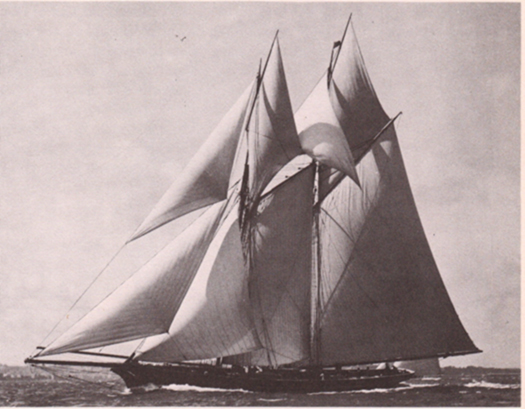
The successful 1865-built schooner Egeria, owned by John Mulholland from Belfast, was renowned for racing right up to the waterfront in Dun Laoghaire with all sail set
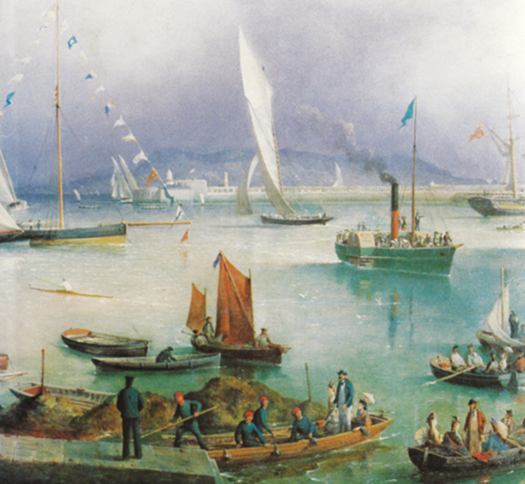
Classic Dun Laoghaire regatta scene by Richard Bridges Beechey. Courtesy RStGYC
The marine artist Richard Breeches Beechey made a speciality of recording these Dublin Bay dramas, and the enthusiastic owners were there to act their roles, no more so than John Jameson of the eponymous whiskey firm, whose successful cutter Irex was a star contender at major regattas all round the coasts of Britain and Ireland. When Irex was back in Dublin Bay, the crowds gathered, for in those days of much more limited entertainment, big boat racing was a must-see spectacle.
Yet at the same time there was something of a revolution going on in sailing, with the racing sport being codified in a movement largely led by the Royal Alfred YC, while small boat racing came centre stage when the Dublin Bay SC was established in 1884, with the one design concept making its appearance with the 13ft Water Wags in 1887.
This was all well and good for the underlying health of sailing. But for traditional yacht clubs with impressive premises which were ultimately there for the great and good to get involved with high end yachting at the height of the summer season, it was a mixed blessing, as each club's annual regatta tried to be all things to all sailing men and the few sailing women, while at the same time keeping the pavilion members happy.

In an age of less sophisticated entertainment, robust waterfront sports were an integral part of the Edwardian era regatta at the Royal St George YC. Photo courtesy Theo Harris
With yacht sizes decreasing, the spectacle and style which under-pinned a classic regatta were increasingly lacking, and while each club's stand-alone annual regatta continued as the centrepiece of its summer programme until well into the late 20th century, the increasing length and variety of the sailing season, and the easy accessibility of other sailing events for specific classes, meant that the traditional Dun Laoghaire regatta was becoming a threatened species.
So in the late 1940s when the newly-formed Irish Dinghy Racing Association was finding success with its annual Dinghy Week at popular sailing venues all round the coast, inevitably there began to be talk of a Regatta Week among the clubs in Dun Laoghaire, with the inevitable comparison to the success of Cowes Week being used to encourage the idea.
You will still hear the comparison to Cowes made from time to time, so let's get something off our chest. There is simply nowhere quite like Cowes. It's on an island, at the epicentre of a very interesting stretch of sailing water. And relatively few people live there. So when the annual Cowes Week is staged, almost every participant is a visitor. To a great extent, this is what makes it special.

The VDLR is ideal for a spot of family racing in all classes including the venerable Water Wags, but this serene mother and daughter crew combination aboard the family Wag is just ever so slightly different. Both are Olympic sailors. That's Cathy McAleavey (470 in 1988) on the spinnaker trim, and her daughter Annalise Murphy (Laser radial in 2012) is on the helm. Photo: VDLR
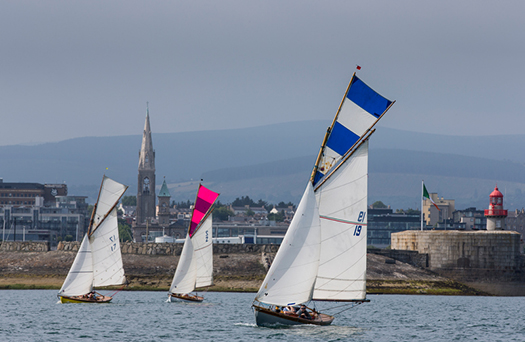
The Howth 17s – established 1898 – make the biennial pilgrimage across Dublin Bay to race in VDLR. Photo: VDLR
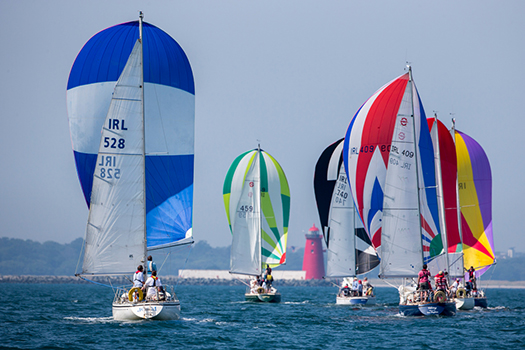
The Shipman 28s may be seen as handy little cruisers at other sailing entres, but in Dun Laoghaire they race as a one design class. Photo VDLR
But at many other sailing places in general, and in Dun Laoghaire in particular, you're right at the heart of a large and affluent resident population. The underlying atmosphere is inherently different, and any successful Dublin Bay event with a regatta flavour has to bear this quietly in mind if it's going to be a success.
Be that as it may, by the mid-1950s a Dun Laoghaire Regatta Week had been rather tentatively introduced, but the Irish economy was so depressed throughout that dismal decade that it was never a runaway success, and without any specifically Irish sailing media to record it, we know virtually nothing of what happened, and in any case it didn't last.
Yet boat numbers were increasing, so for a while the traditional annual Club Regatta had something of a heyday with the perfect balance between fleets afloat and the lack of too many distractions by other sports and interests ashore. For a brave new era, the annual regatta with the clubhouses bedecked in bunting was quite the thing.
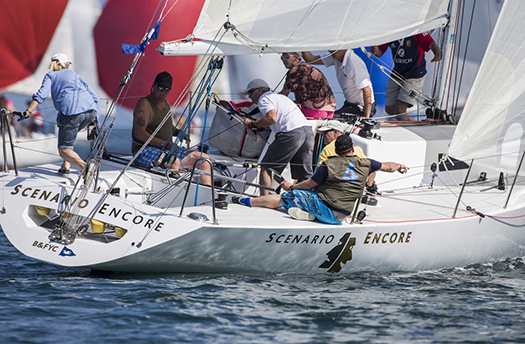
You don't absolutely have to go to Lancashire if you want to recruit a tattooed crew, but it helps. This is Scenario Encore from Blackpool & Fleetwood YC at VDLR 2013. Photo: VDLR

Ever get the feeling that everybody wants to be in the same place at once.......? Photo: VDLR
However, sailing was developing, and there came a new emphasis in the 1970s on offshore racing This in turn led to events like ISORA Week which could be tailored to match the established regatta programme. But then life patterns changed again, offshore racing was seen as almost anti-social, and club officers cast around for a re-shaping of the programme which would provide a compact event which had contemporary appeal for busy people who had many other interests to attend to and obligations to fulfill.
It was three or four years after the turn of the Millennium that the four Dun Laoghaire clubs tasked a working party of their junior flag officers with devising a regatta format which would suit the needs of the 21st Century. Somewhere out there, there has to be an individual original thinker who first proposed the key concept of a four day event evenly spread across all the clubs. We salute him or her, whomsoever they may be. But it went through so many modifications and mutations that the Dun Laoghaire Regatta, as it was first launched some time in late 2004 with the first one scheduled for 2005, had become a completely novel fixture, something carefully tailored to Dun Laoghaire as it has become today, taking into account the way of life of the people who sail from this great and unique port, and the expectations of the people who come to sail with them at their biennial suburban sailfest.
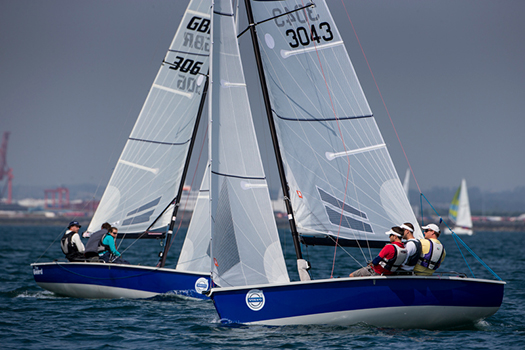
Perfect racing for the SB20s at VDLR 2013. Photo: VDLR
Even in its earliest forms it was such a novel concept that it clearly required someone very special to head up its nascent organising committee, but that was soon put on the right track with Brian Craig of the Royal St George YC put in charge as Chairman. Craig – the quintessential can-do backroom boy who so doggedly remains a behind-the-scenes figure – realised that careful diplomacy was needed if his new committee was going to avoid treading on established toes in the four existing club administration structures.
So he advertised for an administrative secretary with significant experience in office organisation and sailing, yet without any direct personal links to any of the Dun Laoghaire clubs. You'd have though this an almost impossible order with its very specific and unusual job-spec requirements, but they filled the bill precisely with Ciara Dowling. She'd grown up in the Irish countryside with no connection to boats or sailing, yet on any visit to Dun Laoghaire she'd felt drawn to the sport. However, it was while working in London as an office manager in her mid-twenties that she got involved afloat through a corporate outing for a rough day's sailing in the Solent, and was soon hooked while everyone else was sea-sick.
Working in sailing of any kind became her ambition, but it didn't always work out smoothly, yet she managed to put in a formidable amount of sea time and during a period back in Ireland she got signed up for one of the Irish crews (skippered by Tom McWilliam) in the Teachers Round Britain Challenge. By this stage she was finding sailing berths in Dublin Bay while moving between Ireland and London wherever there was boat-related work to be found, but at the time the notice for the Dun Laoghaire Regatta secretary was posted she was living in Howth and had become a member of Howth YC, but was not a member of any Dun Laoghaire club. That seemingly impossible job-spec outline had been hit on target.

Ciara Dowling with her gentlemen friends. The VDLR Secretary with the Chairmen who are (left to right) Tim Goodbody (2015), Adam Winkelmann (2011-2013), Phil Smith (2009), and Brian Craig (2005-2007).
Running what is now the Volvo Dun Laoghaire Regatta is not a full-time job, but as it rolls on through its biennial reincarnations, Ciara Dowling's unrivalled experience of the VDLR in particular and event management in general gives Dun Laoghaire sailing a very smooth management team for an event which can be constantly modified to suit changing tastes, while also competently dealing with a rush of last-minute entries if a good weather forecast comes along, as happened in 2013.
With the discount deadline looming next Tuesday, we'll leave fuller consideration of the fleet for a future date, but be sure that there are plenty of hot boats already in, boats of the calibre of Conor Phelan's Ker 36 Jump Juice from Cork which was pace-setting in Dublin Bay at the ICRA Nationals last year, and also already in the listings in what promises to be a very hot J/109 championship is Liam Shanahan's Ruth from the National, ISORA hotshot and oh-so-nearly winner of last year's Round Ireland.

The VDLR is one of the biggest annual gatherings for the historic IDRA 14 class. Photo: VDLR
And though the mood of the regatta is such that the organisers are very wary of declaring an overall winner, the feeling on the waterfront was that 2013's had been Nigel Biggs' classic Humphreys Half Tonner Checkmate, which has of course recently been sold to Dave Cullen of Howth and is a certain contender this summer.
It takes a while to get your head round the notion of 30 classes (or maybe now it's 31 with the RS Elites throwing their hats into the ring yesterday), and they'll be racing in six different areas under the direction of Race Officers of the quality of Jack Roy and Harry Gallagher.
In all, there are 150 volunteers involved, with a veritable fleet of support RIBs, so every day what mounts to a small navy is going to set out to go to sea to provide what is hoped will be some very special sport.
Tim Goodbody has only been in the chairman's job since the end of last summer, which he feels gives little enough time - he would recommend that any successor gets his feet under the table immediately after the St Patrick's Day holiday in the previous year. In other words, he reckons an absolute minimum of 15 months is required to maximize the success of this unique event.
But as he gets to grips with it, he is effusive in his praise for the support of the Dun Laoghaire Harbour Company, while the continued backing of Volvo through their people at Spirit Motors has kept the show on the road. The regatta's founding in 2005 saw it come into being just as the economy was starting to overheat, yet Volvo came aboard in 2007 and has stayed on as a great pillar of support.
But in the end, the success of it all will come down to you - the competitors. Let us hope that what we've outlined as the long and varied story of regattas in Dun Laoghaire will add to the richness of your experience, and the deeper meaning of an event of this type being held in Dublin Bay. It's no exaggeration to assert that racing in VDLR 2015, no matter what boat you may be sailing, is sailing the dream while being an active part of living history with a future dimension.
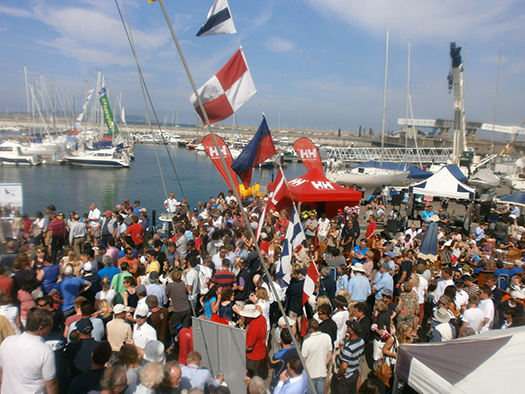
It has been described as "Leopardstown-on-Sea", but it's much better than that......Photo: VDLR
The 2015 Volvo Dun Laoghaire Regatta Programme (with a full entry list) will be published in late June as a supplement to Summer Afloat magazine
Dun Laoghaire Harbour Company Unveils Cruise Berth Plans
#dlharbour – Dun Laoghaire Harbour Company has unveiled a proposed €18m plan to facilitate some of the world's biggest cruise liners inside the harbour walls. A Public consultation will open on the plans for the new cruise berth facility next Monday.
The ambitious new plan is to regenerate the harbour following the loss of the HSS Stena car ferry between Dun laoghaire and Holyhead in February. There is currently no commerical traffic coming in or out of the harbour but a total of 22 cruise ships are expected at the harbour this Summer, bringing up to 100,000 passengers and crew to the east coast port.
The development of the new cruise berth facility is essential to allow to build on the success to date to bring even more vessels and passengers, according to the harbour company, a state owned commerical entity.
The plan will involve the construction of a new quay wall and dredging of the harbour to facilitate ships up to 300 metres in length, (twice the length of the former HSS ferry) which cannot be currently accomodated anywhere else in Ireland other than Cobh in Cork Harbour on the South coast.
The plan is being unveiled this week to harbour and town interest groups including yachts and boat clubs and sailing schools over the course of 20 presentation meetings, according to Afloat.ie sources.
A new 435–metre quay wall be built in the middle of the harbour in front of the east marina breakwater to facilitate cruise ships.
If the plan goes ahead the expected construction period is expected to take 15-18 months. Dredging is expected to be to a depth of 10.5 metres to accoomodate the massive ships.
Members of the public and harbour stakeholders are being invited by the Dun Laoghaire Cruise Stakeholder Group to submit their views on plans for the development.
The two week public consultation process will open next Monday (30.03.2015) and is being launched in advance of an expected planning application to An Board Pleanala for the project. The planning application will be made by Dun Laoghaire Harbour Company on behalf of the Dun Laoghaire Cruise Stakeholder Group.
The cruise industry is an important and growing sector of the tourism market. Cruise ships are getting bigger in size, offering more facilities to passengers, but requiring deeper water and longer berths of accommodate them. Over 50% of new ships currently on order are over 300m in length. At present Cobh is the only port in Ireland that can accommodate these vessels. If facilities are not put in place, Ireland risks losing out on the expanding cruise tourism market.
Under the Planning and Development Acts, the cruise berth facility is regarded as strategic infrastructure and the planning application must therefore be made to An Bord Pleanala. It is expected that a finalised planning application and Environmental Impact Statement will go to An Bord Pleanala the end of April / early May 2015. Responses from the public and stakeholders during the consultation process will be taken into account when finalising the application to An Bord Pleanala. When the final application goes to An Bord Pleanala, observations and submissions may be made by members of the public and certain statutory bodies.
Speaking in relation to the launch of the consultation process, Gerry Dunne, CEO of Dun Laoghaire Harbour Company said: "The Dun Laoghaire Harbour Masterplan, published in 2011, identified the need to develop strategies to ensure the long term future of the harbour, in view of the declining importance of ferry traffic. Development of cruise business was identified as one of the opportunities to be pursued. In addition, Dun Laoghaire is designated as a marine tourism port under the Government's National Ports Policy and the development of the cruise business fits into this framework.
"Dun Laoghaire will have its most successful cruise season ever in 2015, with a total of 22 ships expected, bringing up to 100,000 passengers and crew to the harbour. However the development of the cruise berth facility is essential to allow to build on the success to date and to bring even more vessels and passengers to our town.
"The expansion and development of the cruise business offers significant economic benefits to Dun Laoghaire and the surrounding areas. These would include expenditure by disembarked passenger and crew; payments to tour operators by cruise companies and purchases by cruise ships from local supplies while in harbour.
"This is a hugely exciting project for Dun Laoghaire and the members of the Cruise Stakeholder Group are anxious to hear the views of the public before finalising our application to An Bord Pleanala. Full details of the proposals will be available on the Dun Laoghaire Harbour Website from Monday next at www.dlharbour.ie.
Green Light For Development Of Dun Laoghaire's Victorian Baths
#DunLaoghaire - Dun Laoghaire's Victorian baths will finally get a new lease of life – but not for swimming, as The Irish Times reports.
Revised plans for the revival of the Royal Victoria baths just east of the main harbour – last used 20 years ago as the Rainbow Rapids before falling into dereliction – do not include a public pool, which would have pushed costs up to €20 million.
Instead, the more modest €2.5 million proposal drawn up in 2012 will be pursued, following this week's green light from the Department of the Environment.
This will see the baths developed into artists' studios, a gallery and café space along the lines of the Red Stables in St Anne's Park on the other side of Dublin Bay.
Landscaping works will also see the old saltwater pool space filled in to create a new park between the popular People's Park and the East Pier, which could soon host its own new attraction in the form of an 'urban beach'.
The announcement comes nearly 18 months after Dun Laoghaire-Rathdown County Council applied for foreshore consent to undertake refurbishment works on the derelict baths.
The Irish Times has more on the story HERE.
Fireball Dinghies Led by Dun Laoghaire's Butler & Oram
#dbsc – To a racing observer from the shore, the start of yesterday's Frostbite was very odd! At the scheduled start of 14:00, the first two classes the PY Class and the Lasers got away in proper order writes Cormac Bradley. Quite a bit later there was a start for the RS Classes but as soon as they appeared to go over the line they were all called back. The confusion and delay in the starting sequence meant that the Fireball fleet on the start line was doubled in size, going from three to seven boats, and the fleet got a competitive race in!
Initially the three boats in the start area were Barry McCartin & Conor Kinsella (15114), Noel Butler & Stephen Oram (15061) and Louise McKenna & Hermine O'Keeffe (14691). Having been at a Fireball –connection house-warming the night before I thought that the others had succumbed to the hospitality of the house-warming and decided to give the racing a miss. Because it was gone 14:20 before Kenneth Rumball & Brian Byrne (15058), Louis Smyth & Joe O'Reilly (15007), Frank Miller & Grattan Donnelly (14713) and Neil Colin & Margaret Casey (14775) joined the other three starters. It transpired in the clubhouse afterwards that the fleet emerging from the Coal Harbour end of Dun Laoghaire harbour had been stalled by the Race Committee who were considering their options for the day.
The aborted start for the RS Classes was due, it appears, to two class flags being flown, when only one was required. The nett effect was that all seven Fireballs got a race, sharing the one start.
Having observed the previous starts from shore, I imagined that the Fireballs would be fighting for the committee boat end in order to be able to go right, to a windward mark that was just to the west of the harbour mouth. So it was rather surprising to see McCartin & Kinsella halfway down the start line coming up the beat on starboard tack. The error of that approach manifested itself early on when they went behind the transom of Colin & Casey.
The one boat that did go hard right was rewarded with third place around the weather mark – Smyth & O'Reilly having gone all the way right before they took the hitch into the mark. Rumball & Butler rounded first and second and would keep each other in close company for the balance of the race. Behind Smyth came McCartin, who powered over Smyth between Marks 1 and 2. Miller led Colin and McKenna.
What had looked like a broad reach for the PY and Laser Classes between 1 and 2 was now a tight three sail reach for the Fireballs. Rumball held the spinnaker all the way to 2, Butler did an Aussie drop with about 100m to go, McCartin sailed higher managed to bear of in the tougher gusts to hold the bag all the way to 2. Determining when to gybe after 2 was a key factor in the comfort level of the leg between 2 and 3.
On the second beat the fleet all went right to varying degrees but Rumball & Butler pulled out distance on them all to leave themselves having their own race. A cluster of Fireballs rounded after them, one of whom took a 720˚ penalty turn to leave the sequence as Colin, Miller, Smyth, McCartin and McKenna. At Mark 2 McCartin gybed immediately whereas Smyth and Miller delayed with the result that McCartin took them both. However, by the next mark, McCartin had lost his gains again as the others passed him out. His day got even worse when his spinnaker wouldn't come down at Mark 4 so he retired from the race.
On the third beat the fleet was working inside the area defined by the four marks of the course as opposed to sailing on the extremities. By this stage they were each covering the other with the comfort of knowing that the chasing pack were too far back to threaten. At the end of this third lap however, Rumball fell foul of other boats, at Mark 4 and again when he needed to avoid a capsized 29er. The nett effect was that at the fourth weather mark, Butler & Oram had assumed the lead which they held onto until the finish. Colin led the chasing pack home, followed by Miller, Smyth & McKenna.
DMYC Frostbites – Series 2 R1 R2 R3 R4 R5 R6 R7 Tot Nett
Noel Butler & Stephen Oram 15061 NYC/DMYC 2 3 1 2 3 2 1 14 11
Kenneth Rumball & Brian Byrne 15058 INSC 9 1 3 3 2 4 2 24 15
Barry McCartin & Conor Kinsella 15114 RStGYC 1 4 2 14 1 1 9 32 18
These provisional results (by me) are based on the idea of a single discard for Series 2.
After a balmy but very breezy Saturday here in Dun Laoghaire, the fleet enjoyed more modest temperatures of 8˚ with wind out of the NW (313˚) at 12.5 knots with a highest recorded gust of 21 knots, according to the weather station in the harbour.





























